|
Today, I'm honored to be joined by Leslie Ford, adjunct fellow at the American Enterprise Institute’s Center on Opportunity and Social Mobility and a senior fellow with the Alliance for Opportunity. We discuss: 1) The history of the war on poverty, how safety net programs have evolved, and where the war on poverty stands today; 2) How safety net programs can discourage upward mobility and keep people trapped in poverty through penalties such as those on marriage; and 3) Data on what requirements help safety net recipients achieve long-lasting self-sufficiency and prosperity, and more. You can watch this interview on YouTube or listen to it on Apple Podcast, Spotify, Google Podcast, or Anchor. Please share on social media, subscribe to your favorite platform and my newsletter, like it, and leave a 5-star rating.
Find show notes, thoughtful economic insights, media interviews, speeches, blog posts, research, and more at my website and here in my Substack newsletter. Please subscribe to this newsletter, share it with your friends and family, and leave me a comment.
0 Comments
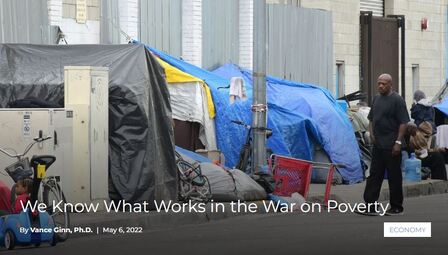 Did you know there’s a state park in Arkansas where you can search for diamonds—real diamonds? And you get to keep what you find. In April, Adam Hardin was visiting Crater of Diamonds State Park and came across a 2.38 carat stone—the largest found so far this year. Diamonds can be found in the 37-acre plowed field, but naturally, they’re rare. It’s a little like the successes that can be seen in our nearly 60-year-old War on Poverty: valuable, but rare. Nationally, about $25 trillion (adjusted for inflation) have been spent to combat poverty since 1964 when President Lyndon B. Johnson’s War on Poverty engendered the Great Society. However, the country’s poverty rate was declining before 1964 but remained virtually unchanged since then, suggesting a failure of these redistributionist measures. But over the years, we’ve learned much. And we know what works in combatting poverty. We also know which key institutions and factors contribute to keeping people in poverty. With good policy—and clearer objectives—we can reverse this trend and truly lift people out of debilitating circumstances that lead to generational poverty. But first, a little history. The 1920–21 recession was the last major economic downturn in American history that was not met with federal intervention designed to stabilize the economy and mitigate poverty. A decade later, Presidents Herbert Hoover and Franklin Delano Roosevelt presided over the first large-scale and nationwide anti-poverty measures during the 1930s and the Great Depression. Despite these large-scale interventions, the unemployment rate remained in double digits for the remainder of the 1930s. More people were dependent on new government programs, and the costly economic effects of these and other government actions reduced both productivity and job creation. A quarter century later, President Lyndon B. Johnson advocated his War on Poverty as part of domestic policy initiatives commonly called the Great Society. But again, poverty relief programs did not substantially accelerate the poverty rate’s reduction—in fact, the rate of decline slowed before essentially stalling. Why? Because these efforts failed to address the real drivers of poverty—in many instances, they became drivers of poverty themselves. There are several factors that are strongly linked with continued poverty and an inability to build income and wealth. The most powerful predictor of poverty in general is single motherhood. Another factor is where you live (including all 41 Texas counties within 100 miles of the U.S.-Mexican border, considered “persistently poor”). And age is also a factor in poverty, but its impact varies depending on other group characteristics. Metro areas with a younger Black population have higher poverty rates, while areas with an older Black population have lower poverty rates. But possibly the most pertinent factor in keeping people trapped in poverty is an incentive not to work or to be more productive. For example, a “benefits cliff” occurs when a safety-net recipient goes back to work, increases their workload, or accepts a higher rate of pay, resulting in increased total earned income—which then triggers a greater loss of payments from government programs. What works? Work. Employment, in general, drives down poverty. By connecting people to work, education, or training, enhancing community-based case management, streamlining safety-net programs, and getting resources to those who need it most, we can create more opportunities for people to be self-sufficient—and thereby reduce the number of Americans experiencing poverty—so long as we have the will, perseverance, and right approach. Finding diamonds in a field of dirt isn’t easy; nor is providing people with a real path out of poverty. But with diligence, and a keen eye, we can see more and more success. https://www.texaspolicy.com/we-know-what-works-in-the-war-on-poverty/ 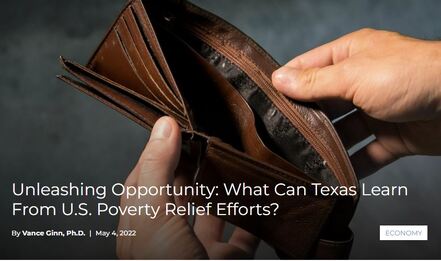 Poverty is often misunderstood because most people do not know who qualifies as poor, how much governmental assistance is available to the poor, or what allows people to escape poverty. Understanding this is crucial to provide more opportunities for work-capable people to attain self-sufficiency with a flourishing civil society as a first resort and effective government programs as a last. Key points • Poverty has long been a public policy concern with roughly $25 trillion (adjusted for inflation) spent on it by governments in the U.S. just since the 1960s’ Great Society in an attempt to help people move out of poverty • But this sort of primary financial assistance by governments has not substantially mitigated poverty and too often made it worse through dependency on government programs. • Instead, there should be a more holistic approach to effectively mitigate poverty through work, community, and opportunity to provide people with long-term self-sufficiency. • Texas and the U.S. can do this with a flourishing civil society and a robust economy as a first resort and effective government programs as a last resort instead of spending more on the current flawed approach. 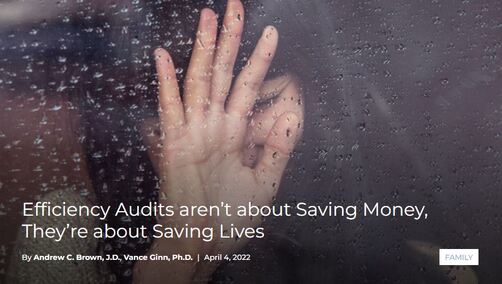 When Uvea was 9, Oregon’s foster care agency couldn’t find a placement in-state, so it sent her to Montana—to a poorly supervised facility where she was drugged, physically restrained and verbally abused by facility staff. “Can I say the two words she called me?” Uvea asked a lawmaker during a later legislative hearing. “They made me feel very uncomfortable. She called me a pervert and a prostitute.” Remember, she was 9 at the time. Untold damage was done to the young girl—but one thing came of it that will benefit all Oregon foster children. Her story sparked an effort to reform Oregon’s child welfare programs, beginning with an efficiency audit. Following the audit, every single child placed out-of-state was brought back to Oregon without increasing the number of foster homes, simply because the state learned how to use its resources more efficiently. And that Montana facility has been shut down. Today, Uvea is 11 years old and living in what she recently told state lawmakers is “the best foster home” she’s ever been in. Too many government programs aren’t achieving their intended purpose. This doesn’t serve the intended recipients—like Uvea—or the taxpayers well. Next session, the Texas Legislature can utilize effective and powerful independent efficiency audits to determine how programs, including Child Protective Services, are performing, where waste can be cut, and what outcomes can be improved. While traditional financial audits can uncover evidence of malfeasance, they only look at the money trail. An efficiency audit goes even further, investigating whether funds are being used for their intended purpose and whether they’re being spent efficiently toward desired outcomes. Bringing in an independent, private sector auditor, rather than the state’s auditor, prevents a potential collusive situation between government entities and provides a fresh perspective that can identify innovative solutions, counteracting the myopic tendencies of government bureaucracy. Last session, the Texas Public Policy Foundation identified the need for independent efficiency audits of the Temporary Assistance for Needy Families (TANF) program and the Department of Family and Protective Services (DFPS), which contains CPS. Both TANF and DFPS have had problems achieving their intended goals. DFPS is a major recipient of TANF dollars in Texas, which is intended to help strengthen families and promote self-sufficiency. DFPS is also responsible for administering the state’s foster care system. In response to the ongoing foster care crisis, the Legislature increased appropriations to the agency. Our internal analysis of corresponding DFPS expenditures raised significant concerns regarding the appropriateness and efficacy of those dollars spent. Specifically, our analysis found that a significant portion of these funds were not getting to the families most in need. Rather, one third of the roughly $1 billion annually in TANF funds are allocated to DFPS, yet half of that third goes to administrative and overhead expenses—things like staff salaries and IT services. That’s money that could have otherwise been used towards its stated intent to help needy Texans. Why was this happening? TANF is primarily funded through a block grant from the federal government, with the rest funded by the state. States have flexibility in how they administer and distribute that funding. While this flexibility can be helpful, DFPS used TANF dollars to fill budget gaps rather than meet its goals. This misuse of TANF dollars by the department revealed a need to investigate whether other agencies were engaging in similar behavior. When we advocated for the use of an independent efficiency audit, we specifically sought to investigate how well both TANF and DFPS were doing at achieving the intended goals of helping Texas families move from dependence to self-sufficiency. Under the new laws passed in 2021 (HB 1516 and HB 2374), that question must be answered every four years before the start of a legislative session. Doing so allows legislators to critique agency appropriations requests more knowledgeably and to ensure taxpayer resources are generating intended outcomes. Because these audits must stay within the bounds of current resources available to each department or agency, taxpayers are assured these efforts will not be used to grow government, but rather evaluate how government could be improved, reformed, or cut. Identifying opportunities to consolidate efforts across separate agencies for example, or when a governmental function might be performed more successfully by a community provider, can provide legislators and the public with solutions that will lead to better services to beneficiaries at lower costs to taxpayers. Oregon, Wyoming, and Kansas are states that have made great strides because of their respective efficiency audits. Louisiana, likewise, recently did an internal efficiency audit of TANF, which the legislative auditor found much needed improvement to achieve the intended goals. Texas Legislators should bring efficiency audits to every aspect of government to generate better outcomes and save taxpayer resources. Little children like Uvea are counting on them. https://www.texaspolicy.com/efficiency-audits-arent-about-saving-money-theyre-about-saving-lives/ 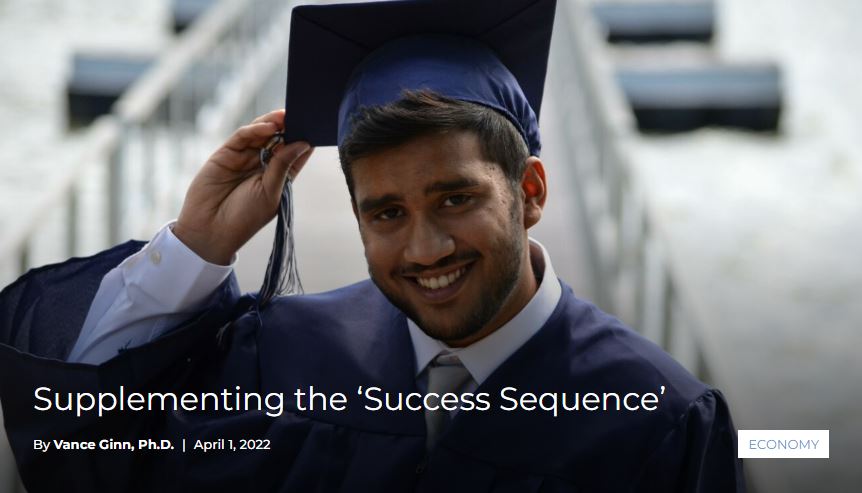 In recent years, there’s been a growing consensus that the “Success Sequence” is a key pathway to avoiding poverty. Unfortunately, this prevailing theory doesn’t fully account for circumstances beyond one’s control. We need a more holistic approach to poverty prevention and alleviation. Brookings Institution fellows Ron Haskins and Isabel Sawhill originally coined the “Success Sequence” in their book, Creating an Opportunity Society. The sequence notes that if you finish high school, get a full-time job, and marry before kids (in that order), you’re more likely to avoid poverty. However, while research finds a strong correlation between this sequence and avoiding poverty (97% of Millennials), proof of causation has been more elusive, leaving gaps in how to achieve lasting poverty relief. The Success Sequence doesn’t account for adverse situations beyond one’s control, such as the diminishing value of a high school diploma, availability of full-time jobs, accessibility to the workforce by the formerly incarcerated, and affordability of housing. Today, one might do everything “right” and still experience poverty. Ultimately, the path to long-term poverty relief includes—but is not limited to—the Success Sequence. To maximize opportunities for success, policies should remove obstacles often imposed by governments. This includes ensuring abundant job opportunities, addressing workforce and affordability issues, and streamlining safety nets. Doing so would allow safety nets to fulfill their purpose as a trampoline to quickly spring people back into self-sufficiency rather than as a hammock that traps recipients into a cycle of dependency on government. Recently, the Texas Public Policy Foundation launched the Alliance for Opportunity initiative with our friends at the Georgia Center for Opportunity and the Pelican Institute in Louisiana. This initiative promotes a strategic policy roadmap for these states that in many ways supplements the Success Sequence. It does so by working to keep vulnerable Americans on track, ensure everyone has a right to earn a living, and address poverty through the justice system. One way is to reform education systems so that career and technical education funding is individualized and institutional funding is tied to employment and wage outcomes. Doing so will ensure students are better prepared for today’s jobs. Consider the return-value funding model for the Texas State Technical College, a two-year institution with an emphasis on technical programs geared toward post-graduation employment. They partner with businesses, government agencies, and other education institutions to coordinate career development routes for students. Notably, the Texas Legislature established an outcomes-based funding model for TSTC based on the annual wages of its graduates five years after graduation. Legislators across the country should utilize similar competency-based models to improve employment outcomes. Policymakers should also be looking for ways to reduce or to remove burdensome occupational licensing requirements and encourage paid apprenticeships throughout the education system in order to protect the right to work and maximize the skills for in-demand jobs. Occupational licensing overall has been shown to restrict the labor market, presenting a significant cost of entry to work, even as there is limited evidence that licenses increase the quality of goods, services, or public safety. States should instead look to implement a systematic process of identifying and removing overburdensome licensing regulations through processes such as a sunset review, while expanding universal recognition of licenses obtained in other states with similar requirements. Moreover, lawmakers should align education and workforce programs to ensure students are able to learn and earn wages as they work. By improving the availability of paid apprenticeships, states can maximize opportunities to find meaningful education and employment. The State of Georgia’s program recently had more than 60% of youth apprentices receive a full-time job offer from their employer upon completion. Finally, for those workers who lose a job unexpectedly, as 22 million Americans did during the government-imposed shutdowns due to the COVID-19 pandemic, legislators should reduce disincentives to work by revamping and streamlining safety net programs. One of the most common reasons recipients are discouraged from pursuing better employment outcomes is the “benefits cliff.” Because of the setup of safety-net programs, many recipients find that a small increase in earnings will result in a large loss of benefits. This creates a vicious cycle of dependency and despair. States must flatten these “cliffs” by leveraging their flexibility with block grant programs and waivers in federal law while keeping the programs tied to work, training, or education, such as an empowerment accounts pilot program. The Success Sequence is a noble, beneficial approach to help avoid poverty, but ultimately its application has gaps that should not be taken for granted. With the Alliance’s strategic policy roadmap, we hope to provide an improved situation with more opportunities in a flourishing civil society that helps those in need achieve financial self-sufficiency, dignity, and purpose faster and longer. https://www.texaspolicy.com/supplementing-the-success-sequence/ 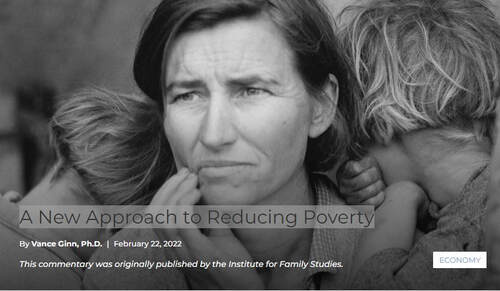 We think about poverty all wrong. And because we think about poverty all wrong, much of our approach to alleviating it is wrong. Thus, poverty stubbornly persists and the trillions of dollars we spend barely nudges the needle to long-term poverty relief. The problem is the disconnect between what poverty really is and what our public policies are trying to solve. A clear understanding of poverty is offered by Steve Corbett and Brian Fikkert in their book, When Helping Hurts. “While poor people mention having a lack of material things, they tend to describe their condition in far more psychological and social terms…” the authors explain. “Poor people typically talk in terms of shame, inferiority, powerlessness, humiliation, fear, hopelessness, depression, social isolation and voicelessness. Low-income people daily face a struggle to survive that creates feelings of helplessness, anxiety, suffocation and separation that are simply unparalleled in the lives of the rest of humanity.” Most Americans don’t define their self-worth based on material possessions (or lack thereof). But our public policies too often focus on stuff. American families below the poverty line have access to a plethora of programs, benefits, cash, and services that provide them with things, especially since the COVID-19 pandemic. But what they lack is a voice. Alleviating poverty means increasing opportunities to gain human dignity, purpose, and self-sufficiency. Understanding that poverty encompasses more than just a dearth of disposable income is key to addressing the systemic issues at play. Those suffering from real poverty live a very different life and see their condition as something quite different from simply being “broke.” It’s more appropriate to say they lack the social capital—a buzz phrase, sure, but a useful one in this case—upon which to rely. The poor lack many intangible things most of us take for granted, like having marketable skills and using them to contribute to our communities in a way society values. Absent a sense of their own dignity, purpose, and self-sufficiency, people are left with dependency to survive—a poison to the human soul. Any attempt to alleviate long-term poverty with little more than repeated handouts, without also connecting people with work, training, or education and building community connections, is not helping, it’s hurting. If we truly intend to love our neighbor as God has commanded, we must recognize that the War on Poverty, fought LBJ-style with government programs, has been lost. A new approach must be charted—an approach that emphasizes keeping vulnerable Americans on track, developing valuable skills, individualizing plans that help people overcome their specific barriers to employment, and—most importantly—an exit strategy. With few exceptions, the goal should be to help people earn self-sufficiency through increased opportunity and work, not lock them into a lifetime of dependency and despair. A good example of this approach is Bonton Farms, an inner-city Dallas urban farm that provides support for people to bridge the gap from poverty and prison and has helped hundreds of people gain a new sense of dignity and purpose. At Bonton Farms, it’s not about handouts. “This gives a lot of guys the opportunity to change,” one former inmate says. “If they want to do better, they can. If they want to be more than just a street guy, a drug dealer, they can. If they want their kids to watch them be something more, it’s possible. That’s what we show them.” Work is the key. Work means using one’s God-given talents and learned skills to provide a value to the community. Doing so confers on those suffering from poverty the very things they cry out for, such as hope, purpose, and a voice. They gain agency—the ability to make their own decisions—and learn skills necessary for them and their families to prosper. A job is the beginning of an exit strategy out of poverty. This should be a bipartisan issue. Indeed, some of the greatest gains made in recent decades fighting poverty came via the Welfare Reform Act of 1996, passed by Republican majorities in the House and Senate and signed by Democrat President Bill Clinton. But even that was incomplete, and later presidents and governors dropped many of the work requirements that were its centerpiece. These factors contributed to the recent launch of a multi-state poverty relief initiative called the Alliance for Opportunity. This includes three state-based think tanks, the Georgia Center for Opportunity, Pelican Institute in Louisiana, and Texas Public Policy Foundation. With a top-notch team and high-quality work that provides a toolkit for policymakers, we hope to help 1 million people out of poverty in these three states to show proof of what works for other states and for Congress to hopefully follow. Our new efforts must begin with a full and fair assessment of how the current situation is helping keep vulnerable Americans on track. Existing programs, especially at the state levels, must be audited and made more transparent by improving data collection to evaluate desired outcomes. And we must partner with community groups closest to those in need—the real safety nets—while streamlining current programs with new ideas like empowerment accounts. Additionally, we must remove barriers to ensure everyone has the right to earn a living. This includes removing obstacles like unreasonable occupational licensing, delay of a driver’s license for many who were formerly incarcerated, or simply instituting more apprenticeship programs to improve access to skills training. And last, but certainly not least, we must address poverty through criminal justice reforms, which our new initiative aims to do. This includes restoration through diversion programs and specialty courts, life and work skills through rehabilitation and transition programs, and a productive path back into the community for the formerly incarcerated. We must do more than send a check every month like the child tax credit payments sent by Congress in the second half of 2021. We must treat the poor like human beings, not just a number. We must meet them where they are and help them achieve their full potential. If poverty was as simple as a lack of funds, then surely the money spent thus far would have made a bigger dent. But it’s not that simple. It never was. We’ve merely sought too long for easy answers. Now it’s time to roll up our sleeves and pursue a new path to eliminate dependency and restore the dignity of work so that more people can be financially self-sufficient. https://www.texaspolicy.com/a-new-approach-to-reducing-poverty/ 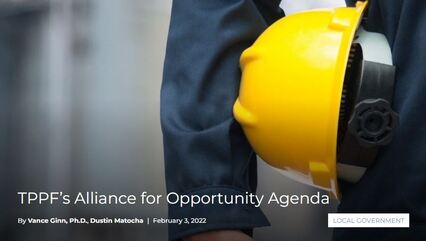 Mission: To enact public policy solutions that promote the human dignity, fruitful purpose, and self sufficiency of every American. https://www.texaspolicy.com/tppfs-alliance-for-opportunity-agenda/  What’s the answer to poverty? I believe it’s opportunity—and hope. I grew up in South Houston, Texas, an urban area of Houston in the 1980s and ‘90s. I lived in a lower-income, single-mother, two-child household. My mostly absent father was on disability due to epilepsy. I had opportunities to attend private school, public school, and finished K-12 in home school. But those years were tough—in a loving yet chaotic home shadowed by traumatic events, budget troubles, and stints of living at my grandparents’ house. Much of poverty is dependent on family structure and location. Kids living with a single mother are much more likely to live in poverty than with a father and mother. And this is associated with less upward income mobility and higher incarceration rates. But some overcome this path by taking available opportunities, whether divinely or otherwise directed. For my part, I made bad decisions in my late teenage years that could have devastated my future in ways that so many others suffer. I started on the right track by working at 16. But I started straying the next year when I began living the “rock star” life as the drummer for a hard rock band. Over the next few years, I found myself walking close to the edge of life and the law. Fortunately, God’s grace—evidenced through a life-threatening car accident—changed this trajectory from poverty, jail, or death to meeting my calling of helping others. I went on to college, earning a doctorate in economics. Then I found a fulfilling career and built a loving family. At every juncture, a combination of grace and opportunity (also, in my view, a manifestation of grace), opened new paths to me. One such opportunity allowed me to earn my high school diploma. Others helped me to start a full-time job, and to get married before having kids. Unknown to me at the time, this is what’s called the success sequence—and it put me in a better position to achieve prosperity. And this success sequence is clearly correlated with less poverty and better family outcomes. But not everyone has the same opportunities I had—most often, because government gets in the way. And that’s precisely why the Texas Public Policy Foundation is releasing its Alliance for Opportunity campaign. This campaign will work closely with similar efforts by the Georgia Center for Opportunity and Pelican Institute in Louisiana in releasing an online roadmap with practical ways to provide poverty relief. The Alliance is working to move people off government dependency onto a path toward self-sufficiency, hope, community, and restorative justice. Ronald Reagan was right when he said, “I believe the best social program is a job.” We need more opportunities for people to receive an education, training, and a job. That’s done by removing obstacles, mostly from government. The need is clear. Nearly 42 million Americans were on food stamps in 2021, up 5.3% from the prior year, showing more people in poverty. Of course, rapid inflation from bad policies out of Washington has made matters worse. Fewer are working; the key labor market measure of the prime-age (25 to 54 years old) employment-population ratio remains depressed. And the misery index remains historically high even during the recovery. These troubling signs for Americans reject the White House’s claim of a robust economy. Dependency and lack of community—of the institutions that give our lives meaning—have led to a rapid rise in deaths of despair. While many of these deaths may have been avoided without the mistaken shutdowns, the key to overcoming poverty’s lethal toll is more opportunities to flourish. Oftentimes government supports abundant opportunities while inhibiting others. But there’s hope. Lives can be saved and improved with strong families, robust civil society, limited government, and free enterprise. Those are the things that make success stories like mine possible. We have our work cut out for us. But I’m ready to go to work to help make the Alliance’s efforts to improve people’s lives more purposeful and prosperous. Join me. https://www.texaspolicy.com/opportunity-overcomes-poverty/ Soon, every Texan will have more opportunity to pursue their dreams, to learn new skills, and to thrive. The Texas Public Policy Foundation’s Opportunity Project supported and tracked important legislation that improved workforce development, removed governmental barriers, and reformed safety net programs—all of which will make Texas a more prosperous state.
The 87th Texas Legislature recently ended sine die with several key victories for Texans—even as the ultimate grade is “incomplete,” with a looming special session to finalize missed opportunities. Among other things, lawmakers made strides toward helping those on the verge of falling through the cracks of society or those already in them. We at the Foundation call these efforts the Opportunity Project, whereby Texans are helping our fellow Texans with a hand up instead of a hand-out. First, legislators successfully implemented programs to assist Texans with strengthening their chances to gain training, experience, and education that provide them with valuable tools for their careers. These tools help keep them from falling through the cracks by empowering them with skills and knowledge that offer them more opportunities to flourish. For Texas to live up to its reputation as a business-friendly state, as well as to protect its liberties and prosperity in the long term, employers need to be able to develop the talents of Texans within their communities quickly and effectively. Texas workers in the hard-hit service sector could benefit from learning new skills to fill specialized roles in IT, manufacturing, construction, and health care. Thanks to Texas Sen. Paul Bettencourt’s and state Rep. John Raney’s HB 4361, more (and more diverse) skills training programs can be launched at community colleges and public universities. The bill allows for more participation by the private sector—the employers who know what they need in the workforce, and are willing to help make it happen. Another bill, SB 1615 expands Goodwill Adult Charters and creates a new subchapter, thanks to Sen. Bettencourt and Rep. Gary VanDeaver. Specifically, this bill provides adult students with an opportunity to earn a high school diploma and an industry certification simultaneously. Sen. Angela Paxton’s and Rep. Harold Dutton’s SB 346 enables charter schools to apply for Jobs and Education for Texans (JET) grant program funding. This bill would simply enable charter schools to have access to the same resources as other public schools, for the benefit of their students and for our state’s economic competitiveness. Representatives Jim Murphy and Tom Oliverson along with Senators Bettencourt and Chuy Hinojosa championed HB 3767 which establishes the Tri-Agency Workforce Commission on a permanent basis. This bill includes data-sharing provisions to improve transparency and accountability. Next, legislators accomplished the removal of certain government barriers. Sen. Nathan Johnson and Rep. James White accomplished passing SB 181 that helps in the criminal justice reform space by re-instating a driver’s license to Texans exiting the criminal justice system conditioned on certain criteria. This is a good measure to help get these individuals back to work. Rep. Scott Sanford and Sen. Royce West propelled HB 569, also known as the Bonton Farms bill, through the legislature to the Governor’s desk. The bill requires a credit per day of confinement toward outstanding fines or costs in a misdemeanor case after the commission of the misdemeanor. This legislation helps reduce in–court costs and fines so that individuals reentering society have better opportunities for self-sufficiency. Rep. Brad Buckley’s HB 139 provides license reciprocity for military members, veterans, and their spouses so they will not be forced to go through a new licensing process for an occupation when they move to Texas from another state. Finally, Texas legislators made multiple safety net reforms. The supplemental nutrition assistance program’s (SNAP) certification process received much needed reform thanks to Sen. Charles Perry and Rep. Armondo Walle. Their efforts culminated in SB 224, which streamlines SNAP’s certification process by reducing the amount of paperwork required for applicants 60 year or older and the disabled. Moreover, Rep. Tan Parker’s and Sen. Drew Springer’s HB 1516 was another successful safety net reform effort that requires routine third-party efficiency audits of the temporary assistance to needy families program (TANF). It requires that these audits determine whether scarce taxpayer dollars for TANF are being used for their intended purpose or for unrelated budget designations. SB 1138 requires a study of the of eligibility requirements, results, and resources for the purpose of streamlining most safety net programs, thanks to Sen. Bryan Hughes and Rep. Candy Noble. It also requires that the study assess the cost of the programs and bureaucracy to taxpayers compared to the benefits recipients and taxpayers receive. There is a need to improve Texas’s inclusive institutional framework for increased job creation and more involvement by civil society that supports the dignity of work, permanent self-sufficiency, and paths to prosperity. The Foundation will continue this effort through the Opportunity Project. |
Vance Ginn, Ph.D.
|

 RSS Feed
RSS Feed